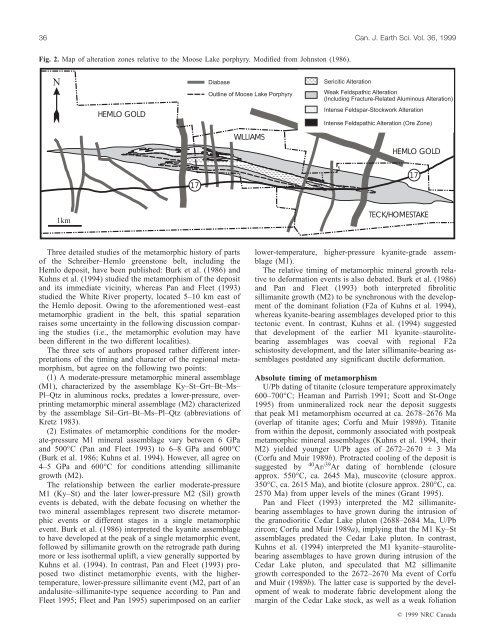Metamorphic history of the Hemlo gold deposit from Al2 SiO5 ...
Metamorphic history of the Hemlo gold deposit from Al2 SiO5 ...
Metamorphic history of the Hemlo gold deposit from Al2 SiO5 ...
You also want an ePaper? Increase the reach of your titles
YUMPU automatically turns print PDFs into web optimized ePapers that Google loves.
36 Can. J. Earth Sci. Vol. 36, 1999<br />
Fig. 2. Map <strong>of</strong> alteration zones relative to <strong>the</strong> Moose Lake porphyry. Modified <strong>from</strong> Johnston (1986).<br />
N<br />
HEMLO GOLD<br />
Diabase<br />
Outline <strong>of</strong> Moose Lake Porphyry<br />
WILLIAMS<br />
Sericitic Alteration<br />
Weak Feldspathic Alteration<br />
(Including Fracture-Related Aluminous Alteration)<br />
Intense Feldspar-Stockwork Alteration<br />
Intense Feldspathic Alteration (Ore Zone)<br />
HEMLO GOLD<br />
17<br />
17<br />
1km<br />
TECK/HOMESTAKE<br />
Three detailed studies <strong>of</strong> <strong>the</strong> metamorphic <strong>history</strong> <strong>of</strong> parts<br />
<strong>of</strong> <strong>the</strong> Schreiber–<strong>Hemlo</strong> greenstone belt, including <strong>the</strong><br />
<strong>Hemlo</strong> <strong>deposit</strong>, have been published: Burk et al. (1986) and<br />
Kuhns et al. (1994) studied <strong>the</strong> metamorphism <strong>of</strong> <strong>the</strong> <strong>deposit</strong><br />
and its immediate vicinity, whereas Pan and Fleet (1993)<br />
studied <strong>the</strong> White River property, located 5–10 km east <strong>of</strong><br />
<strong>the</strong> <strong>Hemlo</strong> <strong>deposit</strong>. Owing to <strong>the</strong> aforementioned west–east<br />
metamorphic gradient in <strong>the</strong> belt, this spatial separation<br />
raises some uncertainty in <strong>the</strong> following discussion comparing<br />
<strong>the</strong> studies (i.e., <strong>the</strong> metamorphic evolution may have<br />
been different in <strong>the</strong> two different localities).<br />
The three sets <strong>of</strong> authors proposed ra<strong>the</strong>r different interpretations<br />
<strong>of</strong> <strong>the</strong> timing and character <strong>of</strong> <strong>the</strong> regional metamorphism,<br />
but agree on <strong>the</strong> following two points:<br />
(1) A moderate-pressure metamorphic mineral assemblage<br />
(M1), characterized by <strong>the</strong> assemblage Ky–St–Grt–Bt–Ms–<br />
Pl–Qtz in aluminous rocks, predates a lower-pressure, overprinting<br />
metamorphic mineral assemblage (M2) characterized<br />
by <strong>the</strong> assemblage Sil–Grt–Bt–Ms–Pl–Qtz (abbreviations <strong>of</strong><br />
Kretz 1983).<br />
(2) Estimates <strong>of</strong> metamorphic conditions for <strong>the</strong> moderate-pressure<br />
M1 mineral assemblage vary between 6 GPa<br />
and 500°C (Pan and Fleet 1993) to 6–8 GPa and 600°C<br />
(Burk et al. 1986; Kuhns et al. 1994). However, all agree on<br />
4–5 GPa and 600°C for conditions attending sillimanite<br />
growth (M2).<br />
The relationship between <strong>the</strong> earlier moderate-pressure<br />
M1 (Ky–St) and <strong>the</strong> later lower-pressure M2 (Sil) growth<br />
events is debated, with <strong>the</strong> debate focusing on whe<strong>the</strong>r <strong>the</strong><br />
two mineral assemblages represent two discrete metamorphic<br />
events or different stages in a single metamorphic<br />
event. Burk et al. (1986) interpreted <strong>the</strong> kyanite assemblage<br />
to have developed at <strong>the</strong> peak <strong>of</strong> a single metamorphic event,<br />
followed by sillimanite growth on <strong>the</strong> retrograde path during<br />
more or less iso<strong>the</strong>rmal uplift, a view generally supported by<br />
Kuhns et al. (1994). In contrast, Pan and Fleet (1993) proposed<br />
two distinct metamorphic events, with <strong>the</strong> highertemperature,<br />
lower-pressure sillimanite event (M2, part <strong>of</strong> an<br />
andalusite–sillimanite-type sequence according to Pan and<br />
Fleet 1995; Fleet and Pan 1995) superimposed on an earlier<br />
lower-temperature, higher-pressure kyanite-grade assemblage<br />
(M1).<br />
The relative timing <strong>of</strong> metamorphic mineral growth relative<br />
to deformation events is also debated. Burk et al. (1986)<br />
and Pan and Fleet (1993) both interpreted fibrolitic<br />
sillimanite growth (M2) to be synchronous with <strong>the</strong> development<br />
<strong>of</strong> <strong>the</strong> dominant foliation (F2a <strong>of</strong> Kuhns et al. 1994),<br />
whereas kyanite-bearing assemblages developed prior to this<br />
tectonic event. In contrast, Kuhns et al. (1994) suggested<br />
that development <strong>of</strong> <strong>the</strong> earlier M1 kyanite–staurolitebearing<br />
assemblages was coeval with regional F2a<br />
schistosity development, and <strong>the</strong> later sillimanite-bearing assemblages<br />
postdated any significant ductile deformation.<br />
Absolute timing <strong>of</strong> metamorphism<br />
U/Pb dating <strong>of</strong> titanite (closure temperature approximately<br />
600–700°C; Heaman and Parrish 1991; Scott and St-Onge<br />
1995) <strong>from</strong> unmineralized rock near <strong>the</strong> <strong>deposit</strong> suggests<br />
that peak M1 metamorphism occurred at ca. 2678–2676 Ma<br />
(overlap <strong>of</strong> titanite ages; Corfu and Muir 1989b). Titanite<br />
<strong>from</strong> within <strong>the</strong> <strong>deposit</strong>, commonly associated with postpeak<br />
metamorphic mineral assemblages (Kuhns et al. 1994, <strong>the</strong>ir<br />
M2) yielded younger U/Pb ages <strong>of</strong> 2672–2670 ± 3 Ma<br />
(Corfu and Muir 1989b). Protracted cooling <strong>of</strong> <strong>the</strong> <strong>deposit</strong> is<br />
suggested by 40 Ar/ 39 Ar dating <strong>of</strong> hornblende (closure<br />
approx. 550°C, ca. 2645 Ma), muscovite (closure approx.<br />
350°C, ca. 2615 Ma), and biotite (closure approx. 280°C, ca.<br />
2570 Ma) <strong>from</strong> upper levels <strong>of</strong> <strong>the</strong> mines (Grant 1995).<br />
Pan and Fleet (1993) interpreted <strong>the</strong> M2 sillimanitebearing<br />
assemblages to have grown during <strong>the</strong> intrusion <strong>of</strong><br />
<strong>the</strong> granodioritic Cedar Lake pluton (2688–2684 Ma, U/Pb<br />
zircon; Corfu and Muir 1989a), implying that <strong>the</strong> M1 Ky–St<br />
assemblages predated <strong>the</strong> Cedar Lake pluton. In contrast,<br />
Kuhns et al. (1994) interpreted <strong>the</strong> M1 kyanite–staurolitebearing<br />
assemblages to have grown during intrusion <strong>of</strong> <strong>the</strong><br />
Cedar Lake pluton, and speculated that M2 sillimanite<br />
growth corresponded to <strong>the</strong> 2672–2670 Ma event <strong>of</strong> Corfu<br />
and Muir (1989b). The latter case is supported by <strong>the</strong> development<br />
<strong>of</strong> weak to moderate fabric development along <strong>the</strong><br />
margin <strong>of</strong> <strong>the</strong> Cedar Lake stock, as well as a weak foliation<br />
© 1999 NRC Canada
















